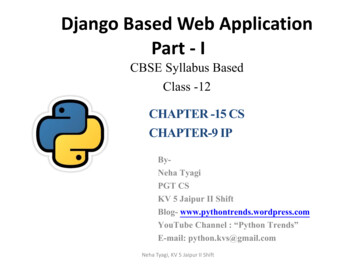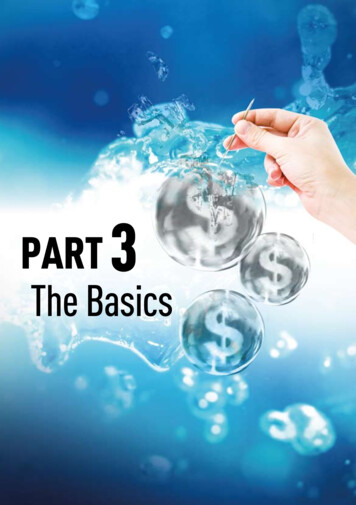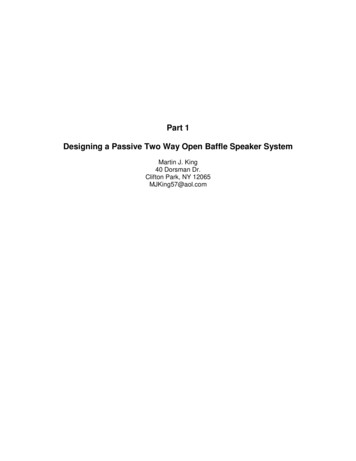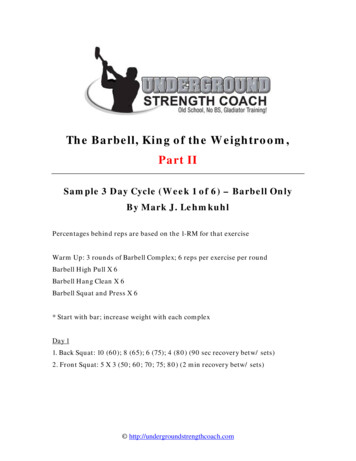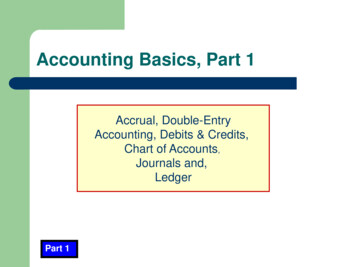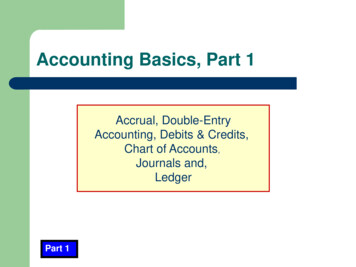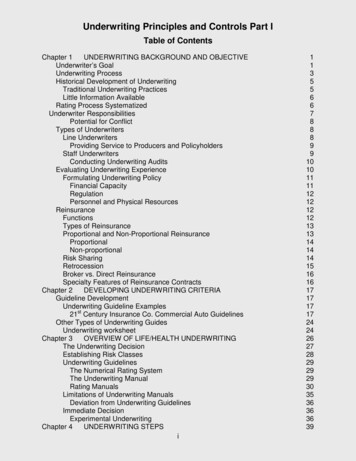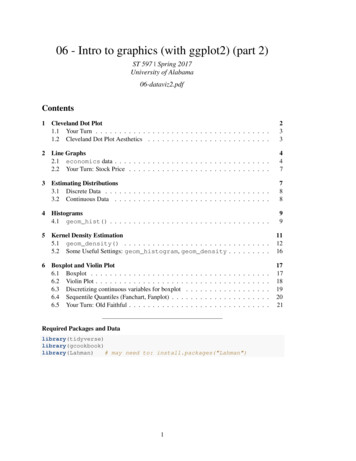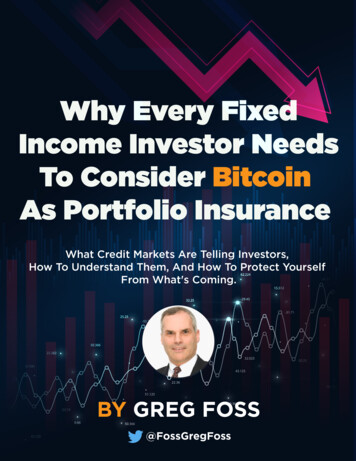
Transcription
Table of ContentsPart 1 . pg. 3Part 2 . pg. 7Part 3 . pg. 21Part 4 . pg. 28Appendix . pg. 342
Part 1Over the last six months, I have hadthe pleasure of being a guest on theRock Star Podcast three separate times(RockStarInnerCircle.com/podcast). This is aproud accomplishment for two reasons.financial innovation and technology that I haveseen in my career. Initially, I loved the idea ofBitcoin due to its hard-capped supply limitof 21million coins. 21million, for the entireworld population, investment community,and everyone looking for a Store of Value thatFirstly, I am proud to have been able to sharewas durable, potable, transferrable, divisible,my opinions on Bitcoin with Tom and Nick andfungible and SCARCE.the amazing audience. While Bitcoin is onlyjust over twelve years old, since 1988 I have Perhaps I am a little geeky, since I am an engineerbeen searching for a solution to Fiat that Bitcoin by training, but when I first saw the blockchainoffers. I am passionate about my discovery. in action on tradeblock.com, together withSometimes I am a little too passionate which transactions that were being processed andcan lead to alienation.stored on the blockchain, I was hooked. I amvisual. For me, seeing is believing (in the tech).Accordingly, I am also proud that I did notfumble my first invite, and that led to a second This weekly blog, in which I plan to submit tenand third invite on the show. I believe each to twelve installments, will not rehash the beautyepisode got better, more in-depth, and free- of Bitcoin and its attributes. There are plentyflowing. That feeling helped me gain the of good books on that subject including Magicconfidence to propose an idea to Tom and Nick Internet Money, A book about Bitcoin, authoredwhereby I want to write a weekly blog to the by Jesse Berger, a fellow Canadian with whomRockstar audience that links my experience in I shared the last Rockstar Podcast stage. Themy thirty-odd year career in the credit markets book is awesome. Jesse is a star, and I don’t needwith the beauty of Bitcoin.to re-hash his eloquent production.Very simply, Bitcoin is the most important What I bring to the discussion is over thirty3
years of risk management and survival in thecredit markets.You need many more performing positions tooffset those that underperform or default.Credit is really misunderstood by most smallinvestors. In fact, in my opinion, credit is alsomisunderstood by many professional investorsand asset allocators as well. As one of Canada’sfirst two sell-side High Yield (HY) bond tradersIn my opinion, credit markets are the most(the esteemed David Gluskin of Goldman Sachsunforgiving of the capital stack. They are alsoCanada being the other), I have lived manythe most ruthless. If you are right, you are paidhead-scratching moments on the trading desksa coupon and you get your principal returned.on Bay Street and Wall Street.If you are wrong, the interest coupon is in I worked at RBC, Canada’s largest bank, in 1988jeopardy, the price of the credit instrument starts when my job was to price C 900MM of Mexicanto fall towards some sort of recovery value, and debt for swap into Brady Bonds. At this time,all sorts of contagion and correlation plays start RBC was insolvent. So were all money centerto come into play. In short, I quickly learned to banks, hence the Brady Plan. RBC’s book valueplay probabilities. Expected value analysis. You of equity was less than the write-down thatcan never be 100% certain.would be required, on a mark-to-market basis,I survived because I adapted. If I realized I hadmade a mistake, I exited (went flat) or evenreversed a position (from long to short or viceversa).I said on the last podcast that Credit Guys arepessimists. That is true because the returndistribution tends to be asymmetric to thedownside. A credit that is out-performing itsrisk profile (i.e. earnings, growth, cash flowsare better than expected) will not increase itscoupon and share that with the debtholders.Those benefits accrue to the equity. As a result,bond traders tend to ask, “How much can I lose?”Equity traders and investors tend to be optimists.They love growth, believe trees grow to themoon, and are generally higher risk takers thanbondies, everything else being equal. This is notsurprising since their priority of claim ranksbelow that of credit (equity is worth zero, unlessbonds are worth par). If you manage moneyprofessionally, equities are for capital gains,whereas bonds are for capital preservation.on its LDC book. That was a scary discovery.Most, if not all financial analysts on the equitydesks had not done this simple calculationbecause they didn’t understand credit. Theyjust felt, like most Canadians do, that the big sixCanadian banks are too-big-to-fail. There is animplicit Canadian government backstop. That istrue, but how would the government back-stopit? Print Fiat dollars out of thin air. Print, print,print Solution Gold since bitcoin did not exist.My experience with insolvent money centrebanks in 1988 would be re-experiencedin 2008/2009 when Libor rates and othercounterparty risk measures shot through theroof PRIOR to equity markets smelling the rat.Again, in late 2007 equity markets rallied tonew highs on Fed rate cuts when the short-termcommercial paper markets and ABCP marketswere shut. The banks knew there was creditEquity guys are expected to lose money on many contagion looming and they stopped fundingpositions provided their winners far outstrip the each other, a classic warning signal. And thenlosers. Bond guys have a more difficult balancing there was 2020. In 2020, the Fed did somethingact, since all bonds are capped to the upside, but totally new on the QE front, it started buyingtheir value can be cut in half an infinite number corporate credit. Do you think the Fed wasof times.buying corporate credit just to grease the lending4
runway? Absolutely not. They were buyingbecause hugely widening yield spreads wouldhave meant banks were once again insolvent in2020. Risky business that banking .good thingthere is a government backstop. Print printprint Solution Bitcoin.Canada.This cross-border arbitrage was huge, andCanada equity accounts had very little idea whytheir equity was getting slashed “ruthlessly”. Iremember one trade that was 100% risk-freeand thus presented an infinite return on capital.In 1995 I had a research article published in the It involved Nova Chem short term debt, and putFinancial Analysts Journal titled Quantifying Risk options. Our CIO, Jason Marks is a Harvardin the Corporate Bond Markets. The article was MBA. An extremely smart engineer who wascited by JPM in a study of Bank for International a brilliant mathematician. But he believed inSettlements capital allocation guidelines for all efficient markets and could not believe I hadcommercial banks globally. When I say that found a risk-free trade with huge absolute returncommercial banks are regularly insolvent (on a potential. To his credit, when I showed him mymark-to-market basis) it is because of this study, trading blotter, and then asked, “How much canwhich essentially quantifies risk for banks that I do?” for risk limit considerations, his answerare levered 25x to their equity cushions.was beautiful. “Do infinity”.(Think government back-stops and Fiat At GMPIM, we also embarked on theimplications. Think Bitcoin as the insurance.)defining trade of my credit career. It was therestructured ABCP or MAV notes. We tradedI worked as HY trader when we brought new C over C 10billion of the notes, from a lowHY debt to market for Rogers Communicationsprice of 20cents on the dollar, right up to a fullInc. At that point in its life, RCI was the largestrecovery value of 100 cents on the dollar. AndHY borrower in the world. RCI issued moreit was all low risk, because we could hedge thedebt into the US HY market than any otherleveraged super senior names with very targetedcompany.Foolish Canadian institutionalpurchases of single-name default insurance.investors would not own the bonds because theWek was a risk management genius. He didn’tbonds were junk, but they owned a subordinateneed to be an equity trader to understand risk.claim .the equity, because the equity was inAsymmetric trades define careers, and ABCPtheir benchmark. Well if the bonds are junk, thewas the best asymmetric trade versus risk, I hadequity is “super-junk”. More to come on this inseen up until that point in my career.future publications.But Bitcoin is a better trade than ABCP, in myI worked at GMPIM, a hedge Fund in 2008/2009opinion. Bitcoin is the best asymmetric tradein the depths of the credit crisis. My partner wasI have ever seen. And I want to explain why inMichael Wekerle (Dragons Den on TV). Wekforthcoming credit-focused publications.is one of the most colourful and experiencedequity traders in Canada. He knows risk. He I believe my trading experience is somewhatquickly understood that there was no point in unique in Canada. I think the various cycles Itaking long positions in most equities until the have lived through give me hindsight to opine oncredit markets behaved. We became a credit- why Bitcoin is such an important considerationfocused Fund, and bought up hundreds of for EVERY fixed income and credit portfolio. Mymillions of dollars of distressed Canadian debt goal is to share these thoughts with the readersin companies like Nova Chemicals, Teck, Nortel, of Rockstar. I hope that you will provide meTD Bank Prefs in the US markets, and hedged with questions and feedback so that I can refineby shorting the equity which traded mostly in my pitch. Together, we can craft a document5
that I would be comfortable presenting to anyfixed-income investor, large or small, to explainwhy Bitcoin needs to be embraced as a kind ofportfolio insurance.to rely on subjective opinions and comfortingassurances from politicians and centralauthorities that it is okay to print more “money”out of thin air. I believe the credit markets willhave a very different take and this could happenOwning Bitcoin does not increase portfolio risk,in short order. We need to be prepared, andit reduces it. You are actually taking MORE riskwe need to understand WHY. “Slowly, thenby not owning bitcoin, than you are if you havesuddenly” is a reality in credit markets.an allocation. It is imperative that all investorsunderstand this, and I hope to lay out the In closing this introduction I want to state threearguments why, using the credit markets as the truisms:most obvious class that needs to embrace the1. Bitcoin math code truth. Never bet“money of the internet”.against open-source platforms.The plan is to start by explaining, in very2. Money has always been technology forgeneral and simple terms, the credit markets.making our work/energy/time todayFor administered rates set by the Central Bankavailable for consumption tomorrow. Bitcoinauthorities, to government bonds and ratingis programmable monetary energy. A Storeagencies, to corporate loans and bonds fromof Value (SoV), transferable on the world’sinvestment grade to High yield (higher risk), tomost powerful computer network. Fiats arestructured products that were largely responsibleworthless, yet they have “subjective value”for the Great financial crisis (GFC) of 2008 andtoday. However, they are programmed to2009.debase. Bond investors are really just aThe GFC just transferred excess leverage in the“derivative” to this reality. Choose your SoVfinancial system, to the balance sheet of thewisely. Think physics and math and code.governments. Perhaps there was no choice but3. Thank goodness that Satoshi had thethere is no question that in the ensuing decade,foresight to design bitcoin in response to thewe had the chance to pay down the debts that welast GFC in 2008/2009. We are headed in ahad pulled forward. We did not do that. Deficitdangerous direction and we are lucky to havespending increased, quantitative easing (QE)this tool. I am not talking as a bond traderwas employed whenever there was a hint of(a pessimist), I am talking as a realist. Thefinancial uncertainty, and now, in my opinion, itbond markets are far larger, and far moreis too late. IT IS PURE MATHEMATICS.susceptible to contagion, than are the equityThe global response to the Covid pandemicmarkets. The credit markets are the dog thathas ensured that our kids’ futures are doomedwags its tail -- equity markets-- and if creditto eternal Fiat currency debasing. Again,markets are not happy, the equity marketssimple math. Unfortunately, most people (andare in for a world of hurt.investors) are intimidated by math. They prefer6
Part 2In the first installment of this series, I detailedmy history in financial markets togetherwith some detail on why Bitcoin is the bestasymmetric trade I have seen in my 32yrs oftrading. I stated that I believe EVERY fixedincome investor needs exposure to Bitcoin inorder to reduce portfolio risk. Obviously, thisis a big claim. In order to back up my assertion,we need to be on a similar footing regarding ourunderstanding of fixed income, and the variousinstruments that exist in the marketplace thatallow for investors to take risk, manage risk(hedge), earn returns, and/or experience losses.I was proud that his journal responded and thathe (the Editor) wanted to further consider myresearch paper but in doing so, would requirethat I agree not to have the piece published inany competing Journal.My article had already been accepted forpublication in the Financial Analysts Journal(FAJ) and I had gratefully accepted. I called Mr.Fabozzi to tell him about my situation and see ifperhaps the research could be published in bothspots. The conversation started nicely, until Iinformed him
I worked as HY trader when we brought new C HY debt to market for Rogers Communications Inc. At that point in its life, RCI was the largest HY borrower in the world. RCI issued more debt into the US HY market than any other company. Foolish Canadian institutional investors would not own the bonds because the bonds were junk, but they owned a subordinate claim .the equity, because the equity .

